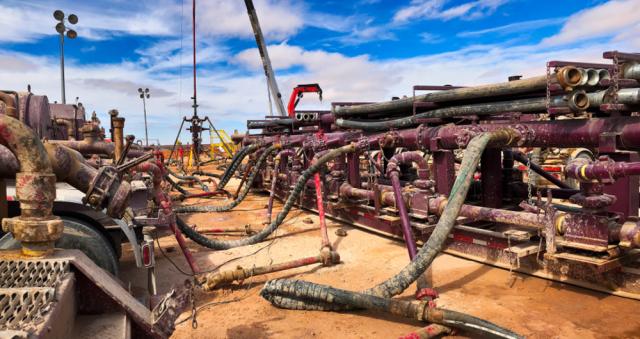
The new year is starting with uncertainty for the oilfield services sector. (Source: Anton Foltin/Shutterstock.com)
- Are efficiency increases too much of a good thing for the stimulation sector?
- E&P companies have been hit with reduced oil prices.
The oilfield services sector will learn soon enough if 2019 fulfills those holiday wishes for a happy new year. The sector—and well stimulation in particular— has just come through holiday-pause mode when a mid to high single digit demand reduction is seasonably expected. Wintertime weather could create choppiness before the market settles into annual cruise mode, just as it did in early 2018.
However, the ambience surrounding winter seasonality morphed into negative sentiment at yearend 2018 as oil prices fell 30% in roughly 60 days. True, there were interrelated factors including E&P budget exhaustion and a temporary oversupply in pressure pumping equipment, particularly in the Permian Basin and Marcellus.
Credit the stimulation sector, which exhibited efficiency improvement in mid-2018 from a greater percentage of pad drilling and zipper fracture stimulation. Stimulation crews added more stages per days and more hours pumping proppant and water downhole. In some cases, pump time improved 15% as stimulation crews captured efficiencies, first in hours and then later in minutes per stage.
Those efficiency gains allowed E&P companies to reach production targets sooner in 2018, and several reported annual budget exhaustion in the fourth quarter, creating white space on stimulation calendars for service providers.
Despite that, published data suggest the drilled but uncompleted well (DUC) backlog is rising and now lies shy of a six-month completion inventory. Although tight formation rig count flattened after Sept. 1, 2018, the industry still has 8,000 wells awaiting a completion crew, according to the U.S. Energy Information Administration.
The pause in demand impacted stimulation pricing, which fell about 15% on the spot market and threatened to reduce pricing from dedicated fleet arrangements as 2019 got underway.
Consequently, the oilfield services sector enters 2019 in a cloud of uncertainty as E&P companies grapple with attaining free cash flow neutrality in a dynamic commodity price environment.
E&P companies ended 2018 with a tailwind from reduced well cost. On the plus side, the transition to in-basin sand mines versus Northern white sand lowered well costs more than 20% in some cases. Furthermore, inflationary pressure from labor shortages abated as overcapacity in stimulation equipment and improved efficiency enabled the industry to do more with less.
The big story in 2018 involved the surge in regional sand use, which accelerated after mid-year 2018.
And that leads back to the main question for 2019. How long will the year-end pause in demand for stimulation services extend? Unfortunately, the industry has an imperfect record on forecasting. For example, expectations of a Permian slowdown in 2019 due to midstream takeaway capacity may not turn out as severe as anticipated.
The expectations that removing Iranian oil from the market via sanctions would keep global oil supplies tight and commodity prices high, gave way at year-end 2018 to fears that the global market will be oversupplied into 2020. This new fear, implying West Texas Intermediate oil prices between $50 and $60, especially in the face of 8,000 DUCs, comes as E&P companies were on the verge of attaining cash flow neutrality in an era where Wall Street no longer funds outspending for the sake of supply growth.
Questions remain as to whether industry observers are overstating demand for sand in the face of rising supply and for pressure pumping as the rate of growth for stage count, tighter spacing, proppant loading and lateral length tops out. Demand—and pricing—for oilfield services follows direction in commodity price.
Happy New Year? We’ll see.
Recommended Reading
EIA’s Three-Figure NatGas Withdrawal Beats Market Expectations
2025-02-06 - Natural gas storage levels are likely to remain below the U.S. Energy Information Administration’s five-year average in 2025 as demand increases for LNG, analysts said.
Gas-Fired Power Plant Announced Close to Austin, Texas
2025-02-06 - The project, to be built by Argan subsidiary Gemma Power Systems, is expected to hook up to the ERCOT grid in 2028.
Renegade Waiting for ‘Catalyst’ as it Mulls Building, Buying Midstream
2025-02-06 - Renegade Infrastructure CEO Drew Ward says the company is currently “basin agnostic” and is considering greenfield projects and M&A after winning a capital commitment from PE firm Energy Spectrum Partners.
Oil Prices Ease as US Tariffs On Mexico Paused for a Month
2025-02-03 - WTI crude futures were down $0.04, or 0.01%, at $72.49 after climbing as much as 3.7% earlier in the session to reach their highest since Jan. 24 at $75.18.
Analysts: How Trump's Tariffs Might Affect Commodity, Energy Sectors
2025-02-03 - Trump's move has sparked volatility in the commodities market. Oil prices rose, with WTI up 2.4% at $74.27 a barrel and Brent crude futures adding 1% to $76.40 a barrel.
Comments
Add new comment
This conversation is moderated according to Hart Energy community rules. Please read the rules before joining the discussion. If you’re experiencing any technical problems, please contact our customer care team.



